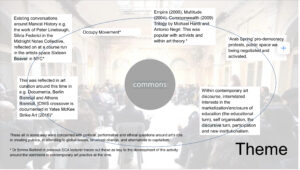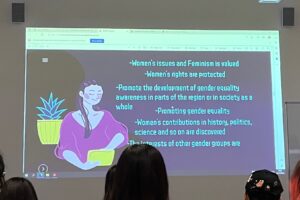Week8&9:Culture Commons
‘…consider how the arts and contemporary theory structure “the commons” anew: how the commons becomes both a goal and a trope in post-millennial art and cultural theory.’ (Amy J. Elias)
I thought that the commons was a new concept because I had no prior knowledge of it. The term ‘commons’ can signify three things: 1) a pool of natural and/or human resources, 2) a community of people with reciprocal and sharing relations, 3) acts of working together towards the reproduction of the community (De Angelis 2017). It is only when these three dimensions come together that we have real commons…. .With the notion of art/commons I want to reclaim an aesthetic and political vision of plenty for the future… (Massimiliano Mollona 2021). In today’s everyday use, the commons is often synonymous with the ‘fair use’ of space. Thus, public galleries, public communities, cultural and creative sites are all part of ‘the commons’.
But the commons does not only include the arts. Science education, engineering, etc. can all be part of the cultural commons. So, it is a broad concept. (Dr Emma Balkind in previous ECA lecturer traces out these as key to the development of the activity around the commons in contemporary art practice at the time. time.)
Thus art as a branch of the development of the cultural commons, when we return to the problematic scenario, we first need to explain: What is the relationship between art and the commons?
Here we assume a large circle, with the commons as the centre, around which the art form develops. Public art is art as a starting point for creating a project of public art, art that values inclusiveness, the exchange of ideas and play and creativity between human (and non-human) entities.1 And the inclusiveness of these arts constitutes one of the characteristics of the commons. In other words, art can be an offshoot of the expression of the commons, and public art can be expressed through the commons.
This week my Basho group presentation was based around ‘culture commons’. We visited other galleries such as the National Gallery of Scotland and Fruitmarket to find out about the characteristics of ‘culture commons’. The presentation was divided into 4 sections: introduction to the theme, observation, reflection and new construction for the future. Here I focus on ‘observation’ and ‘new contribution’.
“The ‘observation’ section was compiled by my team members, and we found many limitations in the development of some of the current galleries, both on site and online.
Offline:
Firstly, as a public cultural resource and an expression of the cultural commons, galleries should not restrict access to groups, but some exhibitions do charge admission.
Secondly, in the case of the Scottish National Gallery, there is a plan and gallery elevation at the entrance gate. a QR code for visit is attached, and the introduction indicates that a map of the venue can be downloaded, but there is no obvious link to download the map when you enter the home page.
Finally, there are many works on display in the gallery, but there are no clear labels to distinguish between the works and their descriptions, which can easily confuse visitors and make it impossible for them to correspond with the location of the works and their descriptions in a short time.
Online (National Galleries of Scotland).
Firstly, there is no multilingual option on the official website, ignoring the needs of international visitors.
Secondly, the website has produced a number of toolkits to attract visitors, but they are not widely available. For example, smartify is online and introduces some works to attract visitors, but the software is not widely available and is not promoted enough. And this software only has instructions to download the app once visitors arrive at the venue.
There are many other limitations of the gallery, and the above presents a more focused section.
At the same time, we found by looking at the data that there has been a significant downward trend in visitor visits to the National Galleries of Scotland since 2019. This suggests that the physical sector has been hit hard by the global New Crown epidemic, so it is debatable how to open up an alternative path of development, or the way in which physical and digital media can work together to serve the cultural commons.

I am responsible for the last section: “new contribution”. In this last section I have presented the story through two branches.
The first is based on the real word, where I discovered from reading the literature that in the real world, public welfare and cultural change play go hand in hand. For example, some people contribute to traditional culture, some to innovative culture, and some to both. So in a multicultural context, the benefits can be enhanced by creating two subgroups, one working with all traditionalists and one with all innovators, with both groups continuing the same game. but separately, with both arising as a new culture.
The second is based on future imagination. I propose the concept of a utopia, in other words, the creation of a utopian cultural commons in the future. We can use the cultural commons as a place of practice and develop it as a place of discovery and adventure, rather than a place of collaboration or collective appropriation. Creating a cultural commons that transcends mundane life and the habits of the crowd.
Learning about culture commons has given me further insight into the commons. I benefited greatly from the presentations of the other Basho groups. What struck me was the topic on feminism chosen by the members of the Purple group. They visited Glasgow galleries as a group and combined their previous artworks to dissect them from a female perspective. I took away a lot from their presentation, such as whether we can understand the concept of the commons by relating it to practice. However, I think that the Purple Group is not supported by enough theoretical literature and data, which is an area that needs further improvement.

To gain a deeper understanding of the commons, I undertook a reading of the theoretical literature.
Firstly, the contemporary urbanised world is a world dominated by interests organised primarily around the economic squeeze of profit. The commons therefore essentially creates a new way of social life, a way of living in the commons. When we link openness and the commons, promoting and building ‘the desocialisation of the commons’ (Hardt and Negri 2009: 258), we are undoubtedly challenging the current capitalist-based society.
Secondly, the cultural commons is not an isolated concept. The cultural commons is important because culture and creativity are playing an increasing role in the fundamentals of economic, social and human-centred environmental development.
Finally, culture, space and community are the main frameworks that constitute the cultural commons, and in the cultural context of building a global community of human destiny, culture is global, spanning ethnicities and continents. Considering the global spread of cultural commons and communities is therefore the way forward for the commons.
Reference:
- Elias, Amy J. “Art and the Commons.” ASAP/Journal 1.1 (2016): 3-15.
- Stavrides, Stavros. Common space: The city as commons. Bloomsbury Publishing, 2016.
- Santagata, Walter, et al. “Cultural commons and cultural communities.” Proc. 13th Biennial Conf. Int. Assoc Study Commons. 2011.




The author has chosen museums and galleries as the subject of a study on common spaces, and presents some of the problems of museum orientation services and some of the drawbacks of online websites such as language or promotion. But I think it is only a critical reflection on the curatorial operations and visual design of museums, and it may lack a real reflection on the future of the common art commons, as the author later mentions about the utopian model more suitable for the development of the art commons, “creating shared cultural spaces that transcend mundane life and the habits of the people. ” This statement I think is more suitable for the concept of anti-utopia, what I think of as the utopian model is the ideal type of society, with a perfectionist social order that does not require people to transcend, so if the author wants to create a utopian model of the art commons he could give more references or artworks and expand on them in detail.
The article lists the problems found by the author in practice and reflects on them, and the content is very detailed. In the process of articles and presentations, I found the concept of utopia mentioned. I have seen the work of FMACM® X Ding Shiwei’s “Goodbye Utopia”, which mentioned that “nothing” does not exist, but a kind of “nothing”. attitude towards the world. If the author wants to research or create a new shared space, he can analyze more reference works and books in the article, which will make the article richer.
The author states that museums and galleries, as common spaces, have many limitations and are not open and public as a whole. However, I think some of them are strategies for gallery operations. Take the ticket fees as an example, art galleries have many considerations. Whether galleries should charge ticket fees has been debated for a long time. The author mentions the concept of utopia in the article, and utopia often contains a broader meaning. It is generally used to describe any ideal, perfect society. It is also sometimes used to describe society’s attempt to turn certain theories into reality. I would like to see the author expand this concept further and describe it.
The author’s blog shows many explanations from books, proving that the blogger has read the literature and has a clear understanding of the commons. The author has responded to each of these issues. It is very intuitive to see in it the evaluation of peers and some data analysis.